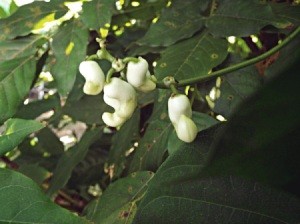 I've gotten some private messages asking for further information on the corkscrew vine (Vigna Caracalla). I'm making this post so all who are interested can share this information.
I've gotten some private messages asking for further information on the corkscrew vine (Vigna Caracalla). I'm making this post so all who are interested can share this information.
The Vigna blooms rather late in the season when grown in the U.S. This is understandable as the US is much farther north than the plant's native tropical habitat. For this reason, I overwintered a plant indoors, rather than starting a new plant from seed in the spring. My purpose was to see if starting with an established plant in the spring would give me blooms earlier than when starting from seed.
My findings: The established plant produced blooms no earlier in the season than when starting from seed. As of September 19, I'm seeing my first beginnings of a bloom. I am in zone 7b. Plants grown further south may produce blooms a bit earlier, and plants grown further north may bloom a bit later.
I don't think the length of growing time is the only factor here. I'm sure the amount of daylight hours and the incremental shortening of those hours, along with other factors, all play a part in when the plant blooms.
The blooms of the Vigna Caracalla are so beautiful and so unique, most people find the rather long wait to be well worth it.
This page contains the following solutions.
I've done 5 posts on a certain vine and still don't know what to call it. I think it could correctly be called Cochliasanthus caracalla. Having a young wisteria standard (tree form) in my back yard, I decided to keep the Vigna in a 5 gallon bucket and let it grow up and around the wisteria rather than on my clothesline.
This vine has the common names, corkscrew vine and snail vine, among others. These two names are rather suitable as the plant bloom is a bit reminiscent of either.
ThriftyFun's slogan is 'ThriftyFun is powered by your wisdom! My tip: Share that wisdom (and/or knowledge). I am trying to hand fertilize my caracalla flowers and don't know if I am anywhere near to doing it correctly.
This flower is beautiful. It has a delicious fragrance somewhat like the lilac, though much heavier and sweeter. A light breeze will bring a concentration of perfume from this flower to the nose.
Check out these photos.
I mentioned earlier in another post that I would be glad to hang my clothes on a tree if these Caracalla vines completely covered my clothes line. Well, that time is just a few days away. Once these things start blooming, they go wild!
This is my last Caracalla picture, this season. If it inspires just one person to grow this beautiful vine next year. I will be happy.
I don't know what this creature is. Maybe a butterfly? Maybe a moth? In my infinite wisdom, I, in another post, accused this little creature of not knowing what it was doing.
Bringing tender plants indoors for the winter can help with not having to replace them every year. This is a page about overwintering corkscrew vine (Cochliasanthus Caracalla or Vigna Caracalla).